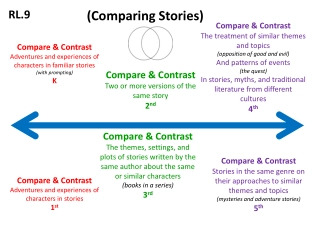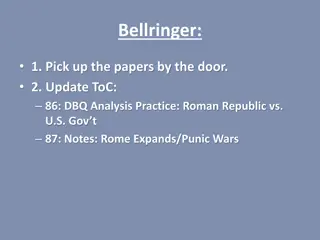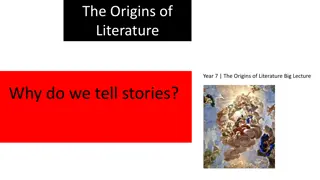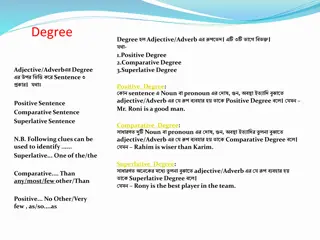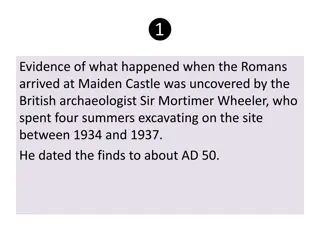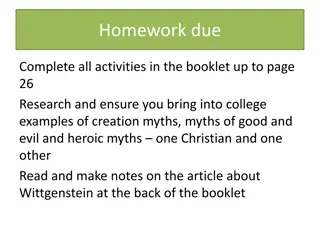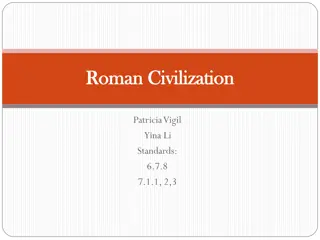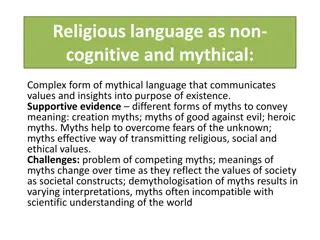Comparative Analysis of Roman Foundational Myths
The task involves analyzing the foundation myths of Rome, focusing on the development, religious, and military initiatives. By comparing Livy and Dionysius' interpretations of Romulus's contributions, considering issues of trustworthiness, and creating infographics on Roman hierarchy and omens, students explore different perspectives on Roman history and governance.
Uploaded on Jul 16, 2024 | 1 Views
Download Presentation

Please find below an Image/Link to download the presentation.
The content on the website is provided AS IS for your information and personal use only. It may not be sold, licensed, or shared on other websites without obtaining consent from the author.If you encounter any issues during the download, it is possible that the publisher has removed the file from their server.
You are allowed to download the files provided on this website for personal or commercial use, subject to the condition that they are used lawfully. All files are the property of their respective owners.
The content on the website is provided AS IS for your information and personal use only. It may not be sold, licensed, or shared on other websites without obtaining consent from the author.
E N D
Presentation Transcript
Political Initiatives 1. What the foundation myths tells us about development of Rome; Religious and Military initiatives. 2. To assess the different interpretations from the ancient sources. TASK: Read p.16 of the book and add the issues with chronology of Romulus to your timeline from last lesson. Summarise these points in your own words but include the dates!
Dionysius vs. Livy TASKS: ISSUE Livy Dionysius Problems 1. Read Livy 1.8 and add into your table a summary of Romulus key contributions on the left. Asylum Safety 2. How does Dionysius describe Romulus contributions differently? Representation CHALLENGE: To your problems column, or by highlighting in your sourcebook, look out for things you cannot trust in the sources. Think: do they include thoughts, feelings or conversations the historian could not know about? 3. Compare this with some of the issues flagged in your textbook and add them to the problems column on the right.
Roman Hierarchy TASK: Create an infographic on the Roman government using the information on p.13. It should include: Tyrant Senators 1. How many people were in each group (roughly)? 2. What type of Romans did each job? 3. How did they exercise power? (use the vocab box on p.13 to help) 4. What were there main jobs? Lictors Farmers
Roman Omens TASK: Read Dionysius 2.9-12 an in pairs add the Greek classes to your infographic in a new colour. Add a sentence on how those classes map onto these Roman roles. Tyrant Senators EXTENSION: Read Dionysius 2.5 why do you think omens are so important in Roman history? Lictors Farmers Sum up how Dionysius compares Romulus to his ancestor using the omen as a device.
Democracy? TASK: Read Dionysius 2.13-14 and highlight inconsistencies in his account. HINT use page 13 of the textbook to help you find the problems. CHALLENGE: Draw your own infographic for how Dionysius claims Romulus ordered his people. It may take a different shape from Livy s! (A) LICTORS The consul was escorted by lictors in public. Lictors carried bundles of rods and axes called fasces. (B) TOGA The toga was a semicircular piece of woollen cloth that was wrapped around the body. (C) CONSULS The consuls were the most senior magistrates. They controlled foreign affairs and commanded the army in wartime. Two consuls were elected each year. (D) SENATORS Only men with experience in government were allowed to join the Senate. There were 300 senators and they served for life.



